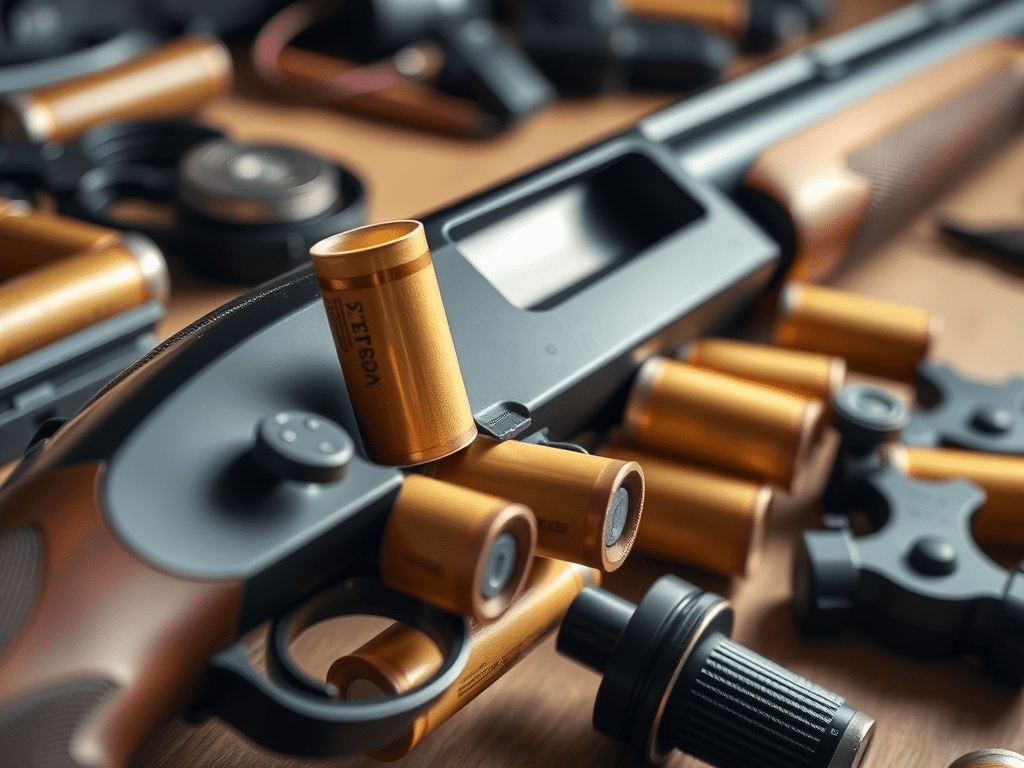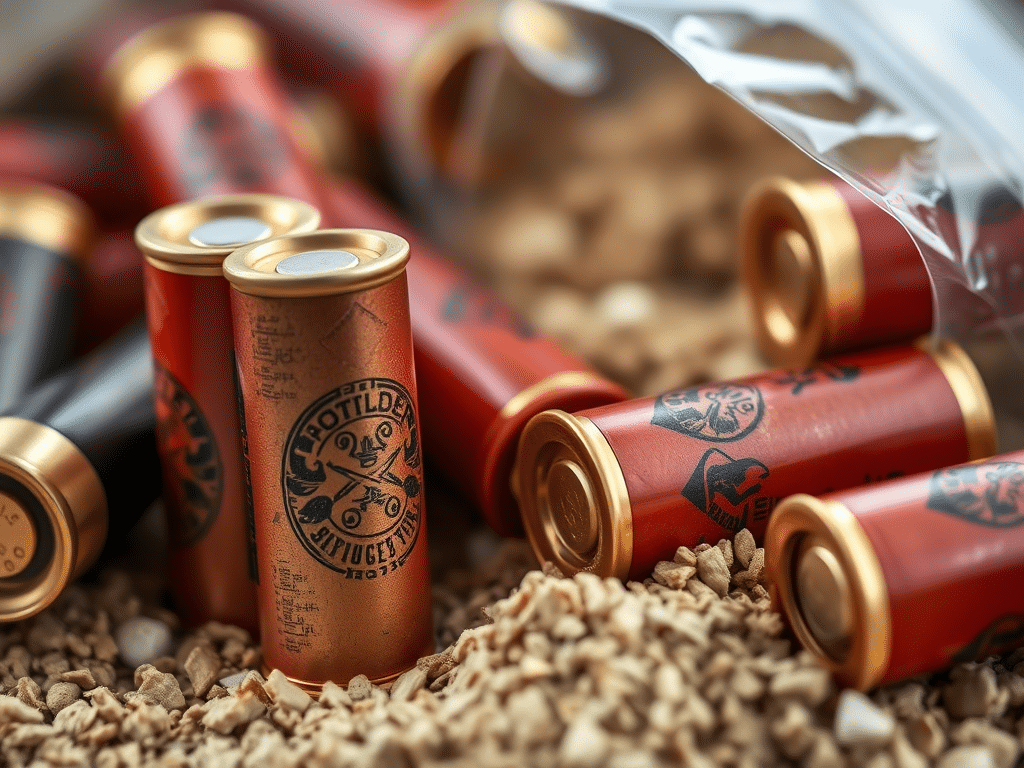The vast majority of professional and experienced hunters prefer to reload their own ammunition, as it not only saves significant costs but also allows for a customized approach to crafting cartridges with desired characteristics. In this article, we will explore how to reload 12-gauge shotgun shells at home.

Why Reload Ammunition Yourself?
Why do hunters choose to reload their own ammunition? Some believe it’s simply about saving money, but that’s not the whole story. While reloading your own cartridges is indeed more cost-effective, there are other important reasons. Why should every hunter know how to properly reload 12-gauge shotgun shells independently?
The key advantage lies in customization: when reloading by hand, you can tailor the cartridge to meet specific performance requirements, with full control over the quality of the components used. Custom cartridge characteristics allow hunters to fine-tune their shotgun’s accuracy and enhance the performance of a specific model. Another critical factor is the type of hunting involved, as each game requires not only a specific tactical approach but also specialized ammunition to increase the likelihood of a successful shot. When reloading, hunters reflect on past hunts, analyze results, and adjust the composition of their ammunition accordingly.
For many hunters, reloading ammunition is more than just preparation for the next hunt—it’s a rewarding hobby that brings immense satisfaction.
Required Materials and Equipment
One of the advantages of reloading ammunition yourself is that some components can be crafted from readily available materials, while others must be purchased from a store. Precision is critical when reloading cartridges, so using electronic or mechanical scales is essential. How can you reload 12-gauge shotgun shells at home accurately and efficiently to save time? A powder dispenser is highly recommended, as it makes measuring the required amount of powder and shot much more convenient. The dispenser must be properly calibrated for the correct powder charge. Experienced hunters often keep pre-calibrated measuring scoops, which have been weighed and tested beforehand. These are extremely practical, as constantly weighing components on scales can be time-consuming.
To insert wads and spacers, you’ll need a wad seater. This specialized tool should fit easily into the shell and firmly press and compact the wads and spacers.
For installing primer caps and removing spent ones, the Sidorenko Universal Tool (UPS) is essential. This device ensures the primer is securely seated in the shell base, as other methods may risk accidental primer detonation.
To crimp the edges of the shell, a crimping tool is required. Crimps can be designed for shot or slug rounds. Additional equipment includes funnels for loading shells, punches for crafting wads and spacers, and a sizing ring. Finally, no cartridge is complete without its core components: powder and shot (or slugs).
Which Shot to Use?

Shotgun Shells with Pellets: How to Load 12 Gauge Ammo for Duck, Pheasant, Capercaillie, and Other Game Birds
Pellet-type shotgun shells are commonly used for hunting ducks, pheasants, capercaillies, and other birds. Let’s take a closer look at how to load 12 gauge shells with pellets and which type to choose.
What Are Shotgun Pellets Made Of?
Pellets are small lead balls with a diameter of up to 5 mm. Lead is the most common material used for manufacturing pellets, but other metal alloys are sometimes used as well:
- Steel Pellets – These don’t deform easily but can damage the barrel. Steel shot is used only at close range because it loses velocity quickly.
- Hardened Lead Pellets – Chemical elements such as arsenic, tin, or antimony are added to the lead to improve its performance.
- Plated Pellets – These are coated with nickel or cupronickel. This is the most expensive and highest-quality type of shot.
Shot Sizes and Their Uses
There is a standard classification system that divides pellets by size, but many hunters prefer a simplified version:
- Small Shot (1.75–3 mm)
- Medium Shot (3–4 mm)
- Large Shot (4–5 mm)
The size of the shot is important for the type of game being hunted. Each bird or animal requires an optimal pellet size for effective results:
- Small birds (quail, snipe, woodcock) – use small shot.
- Medium-sized birds (ducks, black grouse, pheasants) – use medium shot.
- Larger game (hares, geese, capercaillies) – use large shot.
What Type of Gunpowder Should You Use?
The type of gunpowder to use in 12 gauge shells depends on the specific hunting conditions, the desired shot power, and safety regulations. Smokeless powders are most common and come in various brands and burn rates. Be sure to follow reliable reloading data and consult experienced reloaders or manuals to ensure safety and accuracy.

Here’s the full English SEO-friendly translation of your text, tailored for a hunting and ammunition website:
Gunpowder and Bullets: How to Load 12 Gauge Shells at Home for Optimal Performance
Gunpowder is a substance that releases a large amount of energy when ignited. It’s this energy that propels the projectile out of the shotgun barrel. The power of the shot and the distance the projectile travels depend on the amount and type of powder used in the shell. So, how do you hand-load 12 gauge shells to achieve accurate and reliable performance? One of the most important components of a properly loaded shotgun shell is the gunpowder.
Types of Gunpowder
There are several types of gunpowder, categorized by their burn rate. The fastest-burning is black powder. The slowest is rifle-grade powder, which is not suitable for shotgun shell loading. Most hunters prefer something in the middle—smokeless powder, based on either nitroglycerin or nitrocellulose.
The most common nitrocellulose-based powders include:
- Sokol
- Fazan
- Sunar
- Berkut
Popular nitroglycerin-based powders include:
- Bars
- Ballistite
- Cordite
Smokeless powder outperforms black powder in nearly every technical aspect: it’s much more powerful, generates more heat, and doesn’t ignite under atmospheric pressure. Black powder, by contrast, leaves a heavy residue in the barrel that needs to be cleaned frequently, which is inconvenient.
Loading 12 Gauge Shells with Slugs
When loading 12 gauge shells with a slug at home, extra care is required. Unlike shot pellets, which spread and increase hit probability, a slug is a single projectile—so accuracy is key. Proper loading is essential to ensure precise trajectory.
The assembly sequence is similar to shot shells, except for the projectile. The slug must be free from cracks, dents, or deep scratches. Some hunters use 16 gauge slugs in 12 gauge shells. In that case, the slug must be perfectly centered in the hull. You can use a section of a 16 gauge cardboard shell, wrapped with stabilizing material on three sides to keep it aligned.
Loading Buckshot Shells
Buckshot refers to large-diameter pellets, over 5 mm in size. This type of ammo is used for hunting large game such as wolves, goats, or bustards.
Only paper hulls should be used for loading buckshot—preferably new ones. Brass hulls may deform the barrel upon firing. Always load stacked buckshot, not loose. Buckshot must be tightly packed into the 12 gauge hull with no empty space between the balls. This ensures accuracy and safety.
For a 12 gauge shell, use 2.1–2.2 grams of Sokol powder. Always use smokeless powder. The remaining loading steps are the same as for standard shot shells.
Material Ratios
To determine the projectile weight, you need to know the weight of the gun. For 12 gauge, use this formula:
- Projectile weight = 1/94 to 1/100 of the total gun weight
After calculating the shot weight, determine the powder charge. Manufacturer-recommended ratios on powder packaging are often too generic. Use these more accurate ratios:
- Black powder: 1/5 to 1/6
- Smokeless powder:
- Sokol: 1/16 to 1/18
- Bars: 1/18
The first number is the powder weight, the second is the projectile weight. Final tuning should be done through test firing.
Common Mistakes When Loading 12 Gauge Shells
- Improper equipment: Some beginners try to load shells using makeshift tools. For proper primer seating, use a dedicated reloading press, such as the UPS-5.
- Incorrect ratios: If powder-to-projectile ratios are off, best case—poor performance. Worst case—heavy recoil or even a dangerous explosion that could injure the shooter.
- Defective hulls: Deformed or damaged hulls should be discarded. Using bad hulls can lead to catastrophic shell failure.
- Improper crimping: A poorly crimped shell can deform the hull, affect firing accuracy, or significantly increase recoil.
Proper equipment, attention to detail, and respect for safety guidelines are crucial when hand-loading 12 gauge shotgun shells.
